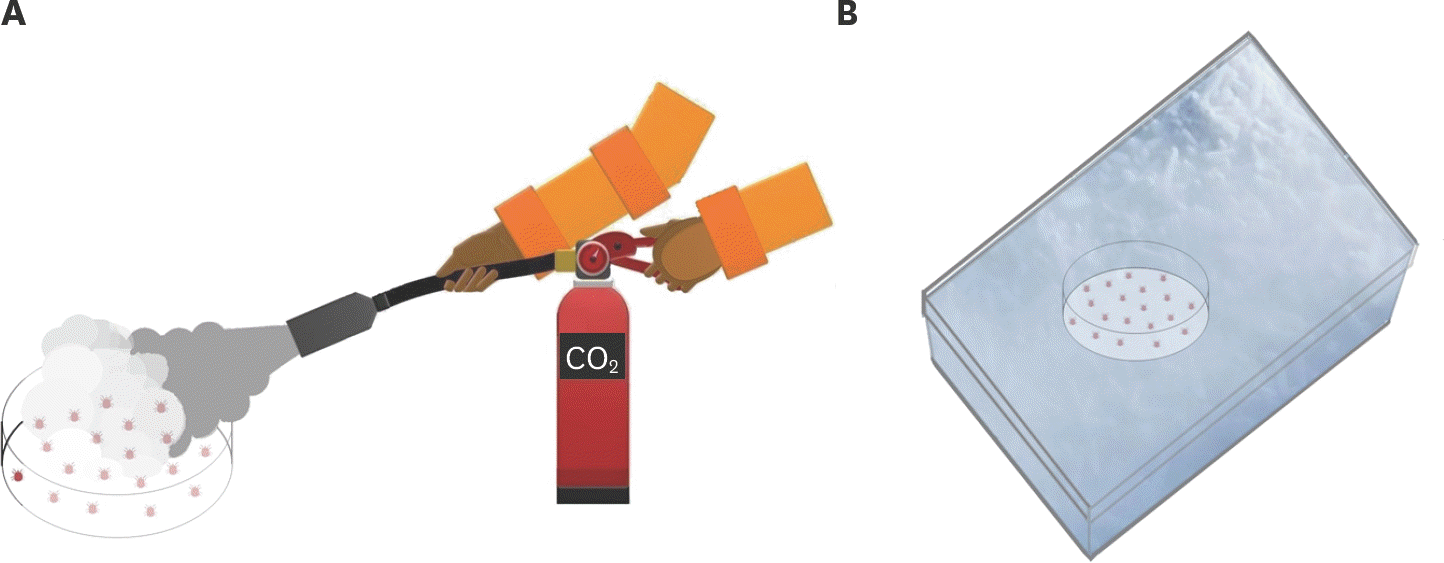Abstract
Poultry red mites (PRMs), Dermanyssus gallinae, are one of the most harmful ectoparasites of laying hens. Because of their public health impact, safe, effective methods to eradicate PRMs are greatly needed. Carbon dioxide (CO2) was shown to eradicate phytophagous mites; however, there is no evidence that PRMs can be eradicated by CO2. Thus, the efficacy of CO2, applied by direct-spraying and dry ice-generated exposure, for eradicating PRMs was investigated. Both treatments eradicated > 85% of PRMs within 24 h and 100% of PRMs by 120 h of post-treatment. Therefore, these novel approaches may be useful for eradicating PRMs in clinical settings.
Go to : 
References
1. Kirkwood AC. Anaemia in poultry infested with the red mite Dermanyssus gallinae. Vet Rec. 1967; 80(17):514–516.
2. Sikes RK, Chamberlain RW. Laboratory observations on three species of bird mites. J Parasitol. 1954; 40(6):691–697.

3. Sparagano OA, George DR, Harrington DW, Giangaspero A. Significance and control of the poultry red mite, Dermanyssus gallinae. Annu Rev Entomol. 2014; 59(1):447–466.
4. Zeman P, Stika V, Skalka B, Bártík M, Dusbábek F, Lávicková M. Potential role of Dermanyssus gallinae De Geer, 1778 in the circulation of the agent of pullurosis-typhus in hens. Folia Parasitol (Praha). 1982; 29(4):371–374.
5. Hungerford TG, Hart L. Fowl tick fever. Agric Gaz. 1937; 48:591–592.
6. Beugnet F, Chauve C, Gauthey M, Beert L. Resistance of the red poultry mite to pyrethroids in France. Vet Rec. 1997; 140(22):577–579.

7. Marangi M, Cafiero MA, Capelli G, Camarda A, Sparagano OA, Giangaspero A. Evaluation of the poultry red mite, Dermanyssus gallinae (Acari: Dermanyssidae) susceptibility to some acaricides in field populations from Italy. Exp Appl Acarol. 2009; 48(1-2):11–18.

8. Zeman P. Encounter the poultry red mite resistance to acaricides in Czechoslovak poultry-farming. Folia Parasitol (Praha). 1987; 34(4):369–373.
9. European Food Safety Authority (EFSA). Occurrence of residues of fipronil and other acaricides in chicken eggs and poultry muscle/fat. EFSA J. 2018; 16(5):5164.
10. Mullens BA, Murillo AC. Parasites in laying hen housing systems. Hester PY, editor. editor.Egg Innovations and Strategies for Improvements. London, United Kingdom: Elsevier;2017. 597-605.

11. White NDG, Jayas DS. Control of insects and mites with carbon dioxide in wheat stored at cool temperatures in nonairtight bins. J Econ Entomol. 1991; 84(6):1933–1942.

12. Chirico J, Tauson R. Traps containing acaricides for the control of Dermanyssus gallinae. Vet Parasitol. 2002; 110(1-2):109–116.
13. Pavlićević A, Ratajac R, Dotlić M, Stojanov I, Pavlović I. An innovative formulation of paraffin and silicone oils for the control of the red poultry mite (Dermanyssus gallinae) – examination of the efficiency under laboratory conditions. Arh Vet Med. 2017; 10(2):63–79.

14. Hamscher G, Priess B, Harting J, Nogossek MI, Gluender G, Nau II. Determination of propoxur residues in eggs by liquid chromatography–diode array detection after treatment of stocked housing facilities for the poultry red mite (Dermanyssus gallinae). Anal Chim Acta. 2003; 483(1-2):19–26.

15. Ministry of Food and Drug safety. Guideline for testing efficacy of insecticide for prevention of infectious diseases [Internet]. Cheongju: Ministry of Food and Drug safety;. https://www.mfds.go.kr/brd/m_218/view.do?seq=1119&srchFr=&srchTo=&srchWord=%EC%82%B4%EC%B6%A9%EC%A0%9C&srchT-p=0&itm_seq_1=0&itm_seq_2=0&multi_itm_seq=0&company_cd=&company_nm=&Data_stts_gu-bun=C9999&page=1. Accessed 2020 Feb 26.
Go to : 
 | Fig. 1.Schematic representations of CO2 treatment methods to eradicate PRMs in this study. (A) Direct spraying of CO2. (B) Exposure to dry ice-generated CO2 in a closed chamber. CO2, carbon dioxide; PRM, poultry red mite. |
Table 1.
Efficacy of CO2 treatment for the eradication of poultry red mites using different application methods




 PDF
PDF Citation
Citation Print
Print


 XML Download
XML Download